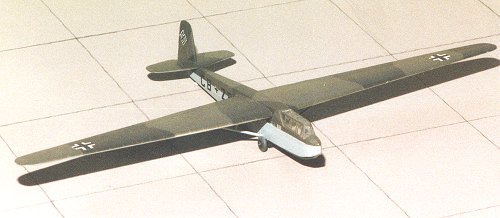
Huma 1/72 DFS.230
Kit Number: 3000
Price: $28.00 retail
Decals: Two versions; a standard and that used for Mistel testing with a Bf-109
Review and Photo by: Scott Van Aken

The DFS-230 assault glider was the first glider to be used in large-scale assaults. This 11 man glider was used with great effectiveness during the German's assault on the Belgian Fortress of Eban Emael in 1940. These gliders actually landed on the roof of the fortress allowing German troops to quickly overcome its defenders. It was also used in great numbers in Russia, the Med, and Northern Africa. Often when a squadron moved from one place to another, it was the DFS-230 that was used to haul parts and mechanics. Light enough to be towed by a single-engined Ju-87, it was not uncommon for several to be towed by a Ju-52 or Bf-110. The 230 was also used to prove the Mistel concept, and that aircraft along with the appropriate braces are supplied with the Huma kit.
Huma kits are really superb and offer subjects that are unavailable from any other source in injected plastic. Molded in a soft, white plastic, the detailing is quite good. It has often been called a limited production kit, but since it uses steel molds, that appellation does not hold true. The DFS-230 was one of their earlier kits and so has rather large sprue gates. Thanks to the soft plastic, these are easily removed. Also included in the kit are a comprehensive decal sheet and an excellent instruction sheet, written in German and English. In the newer kits, there are also a number of photographs of the subject.
 The interior consists of basic cockpit components; a seat, flooring and control
column. There is nothing in the passenger bay. Little can be seen of
it anyway through the small cabin windows. The interior was painted
RLM 02 grey. Next the windows were installed and the fuselage halves glued
together. The horizontal stabilizer is one piece and slips into the
cutout under the fin. The wings are each a single piece and fit well
into slots in the fuselage. Naturally, I needed some putty along all
the joins. The landing skid and tail skid were then glued to the underside
of the fuselage. It was then that the canopy was attached and all the
transparencies were masked prior to painting. The wing struts were
painted separately and joined after overall painting was done to ease
construction.
The interior consists of basic cockpit components; a seat, flooring and control
column. There is nothing in the passenger bay. Little can be seen of
it anyway through the small cabin windows. The interior was painted
RLM 02 grey. Next the windows were installed and the fuselage halves glued
together. The horizontal stabilizer is one piece and slips into the
cutout under the fin. The wings are each a single piece and fit well
into slots in the fuselage. Naturally, I needed some putty along all
the joins. The landing skid and tail skid were then glued to the underside
of the fuselage. It was then that the canopy was attached and all the
transparencies were masked prior to painting. The wing struts were
painted separately and joined after overall painting was done to ease
construction.
The standard scheme for this is RLM 70/71 uppers and RLM 65 lowers. Gunze acrylic paints were used for these colors and they covered well. Once the paint had dried, I put on the decals, choosing the ones for the DFS230 used during Mistel trials. There were very matt and needed trimming to get rid of excessive clear around the decals. The Microscale system worked very well with these. Once done, the airframe was sprayed with a semi-gloss and when dry the masking taken off the transparencies. The last assembly items were the wing struts and wheeled take-off dolly.
Overall the kit assembled well and was relatively easy to build. Huma kits have always pleased me and I will continue to build more of them. They are just now getting into 1/48. The kits are rather pricey for what you get, but you get something that no one else produces. Highly recommended.
31 March 1998
Copyright ModelingMadness.com. All rights reserved.